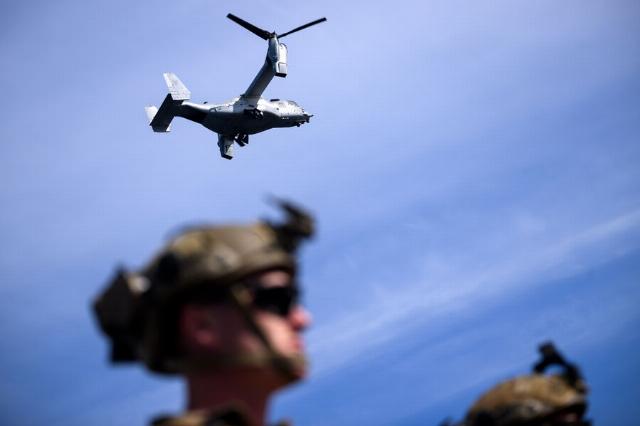NATO launches a patrol mission in the Baltic Sea
NATO is launching a patrol mission in the Baltic Sea to ensure infrastructure security. This is caused by recent damage to underwater cables. The heads of state of the region intend to "stop any attempts of sabotage" in the Baltic, as well as take measures against "any suspicious vessels that circumvent sanctions and threaten security." Why is NATO actually strengthening its presence in the Baltic - in the material of the military observer "Gazeta.Ru" by Mikhail Khodarenka.
The NATO Operational Command (ACO), responsible for planning and conducting all NATO operations, is creating the Baltic Sentry system in the Baltic Sea to prevent any attempts to damage the critical underwater infrastructure of the member states of the North Atlantic Alliance in this region. This is caused by recent damage to underwater cables.
"The Baltic Sentry will carry out targeted deterrence throughout the Baltic Sea and counteract destabilizing actions," said Christopher J. Johnson, Supreme Commander of the NATO Joint Armed Forces in Europe. Cavoli. The Baltic Sentry mission will involve frigates and patrol aircraft, as well as a fleet of unmanned offshore boats.
Cable breaks
On November 17-18, 2024, a message was received about the breakage of an underwater communication cable by the telecommunications company Telia Lietuva between Lithuania and Sweden. A little later, the C-Lion1 communication cable connecting Finland with Germany was damaged. In early December 2024, the rupture of fiber optic cables of the telecommunications company GlobalConnect between Sweden and Finland was recorded.
On December 25, the EstLink 2 cable providing electricity transmission between Estonia and Finland was damaged. And on January 14, another underwater cable connecting Sweden, Lithuania, Germany and Finland was broken in the Baltic Sea.
This time, the patience of the Baltic states participating in the North Atlantic Alliance has run out, and a summit of NATO allies on the Baltic Sea was held in Helsinki. It was attended by Finnish President Alexander Stubb, Estonian Prime Minister Kristen Michal, Danish Prime Minister Mette Frederiksen, German Federal Chancellor Olaf Scholz, Latvian President Edgar Rinkevich, Lithuanian President Gitanas Nauseda, Polish Prime Minister Donald Tusk and Swedish Prime Minister Ulf Kristersson in the presence of NATO Secretary General Mark Rutte and Executive Vice President- The President of the European Commission, Henna Virkkunen, issued a joint statement.
"We welcome the fact that NATO has launched the Baltic Sentry increased vigilance measures to improve situational awareness and deter hostile actions. We welcome the efforts of the Allies to deploy additional forces and assets at sea, in the air, on land and below the surface of the sea to increase vigilance and deterrence," the heads of State of the Baltic Sea noted.
The statement notes that the countries are "determined to deter, identify and stop any attempts at sabotage."
What does the "shadow fleet" have to do with it?
Among other things, the document says: "... Russia's use of the so-called shadow fleet poses a particular threat to maritime and environmental security in the Baltic Sea region and around the world. This reprehensible practice also threatens the integrity of the underwater infrastructure, increases the risks associated with chemical munitions dumped at sea, and significantly contributes to the financing of Russia's illegal aggressive war against Ukraine." And it is worth paying special attention to this.
But further, in the joint statement of the summit of NATO allies on the Baltic Sea, very specific measures are proposed.: "We reserve the right, in accordance with international law, to take action against any suspicious vessels that circumvent sanctions and threaten our security, infrastructure and the environment. In close cooperation with coastal States, we are strengthening vessel surveillance, including checking insurance certificates."
It remains to clarify - and how does NATO represent these actions practically? Boarding parties on "suspicious vessels"? However, civilian vessels on the high seas under the flag or with the identification mark of Russia are the territory of our state. And the "insurance certificate check" can easily end in a shootout, which will entail unpredictable consequences.
And most importantly, the patience of the NATO allies in the Baltic Sea may have run out. But the direct culprits of the damage to the submarine cables of the Baltic states have not yet been identified and, of course, have not been brought to justice. And the tanker fleet is here, at hand. In general, as a conclusion, we can say this: after such statements, the waters of the Baltic Sea begin to rapidly heat up, if not boil.
The opinion of the author may not coincide with the position of the editorial board.
Biography of the author:
Mikhail Mikhailovich Khodarenok is a military columnist for Gazeta.Ru", retired colonel.
He graduated from the Minsk Higher Engineering Anti-Aircraft Missile School (1976), the Military Air Defense Command Academy (1986).
Commander of the S-75 anti-aircraft missile division (1980-1983).
Deputy commander of the anti-aircraft missile regiment (1986-1988).
Senior Officer of the General Staff of the Air Defense Forces (1988-1992).
Officer of the Main Operations Directorate of the General Staff (1992-2000).
Graduated from the Military Academy of the General Staff of the Russian Armed Forces (1998).
Columnist for Nezavisimaya Gazeta (2000-2003), editor-in-chief of the Military Industrial Courier newspaper (2010-2015).
Mikhail Khodarenok

